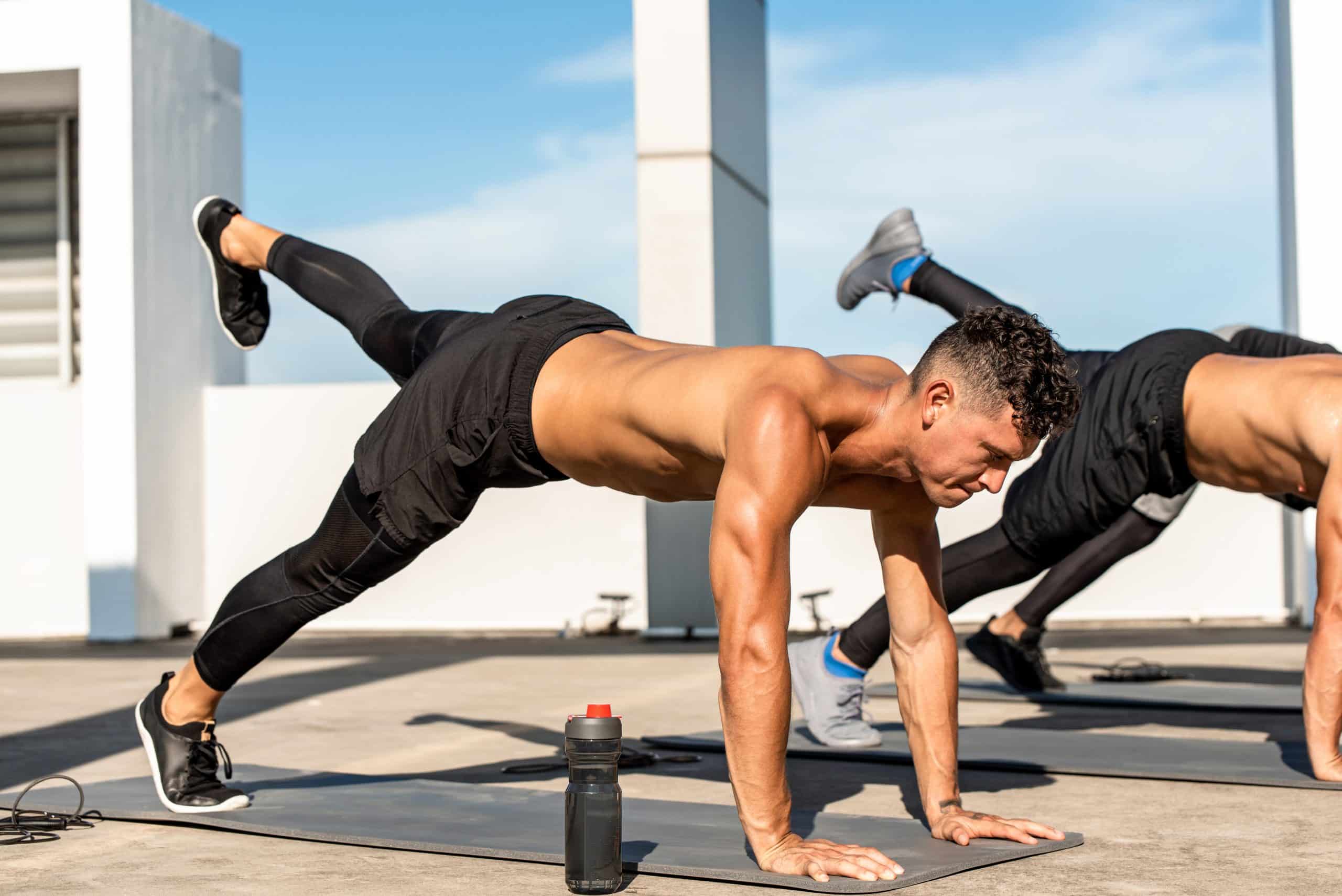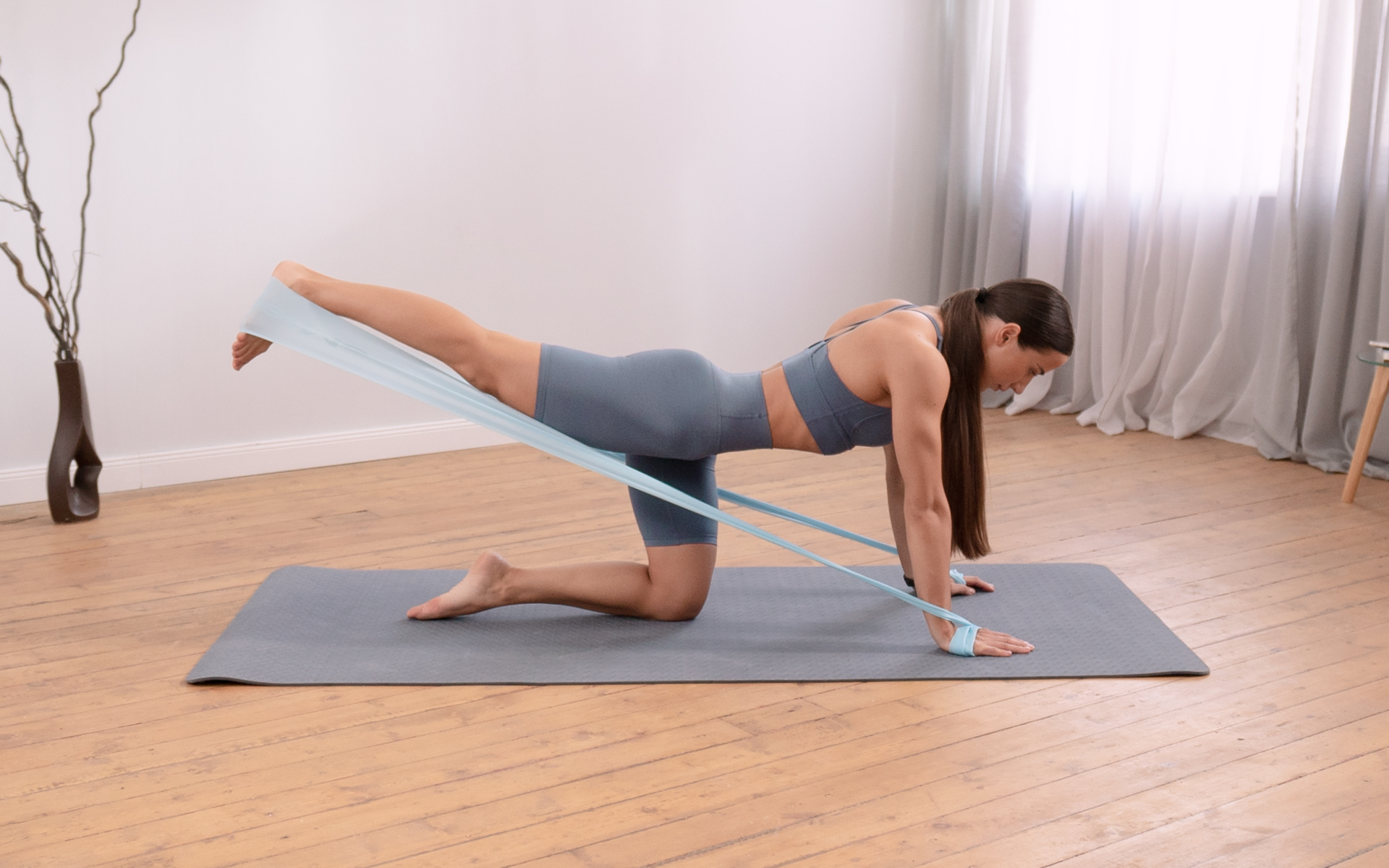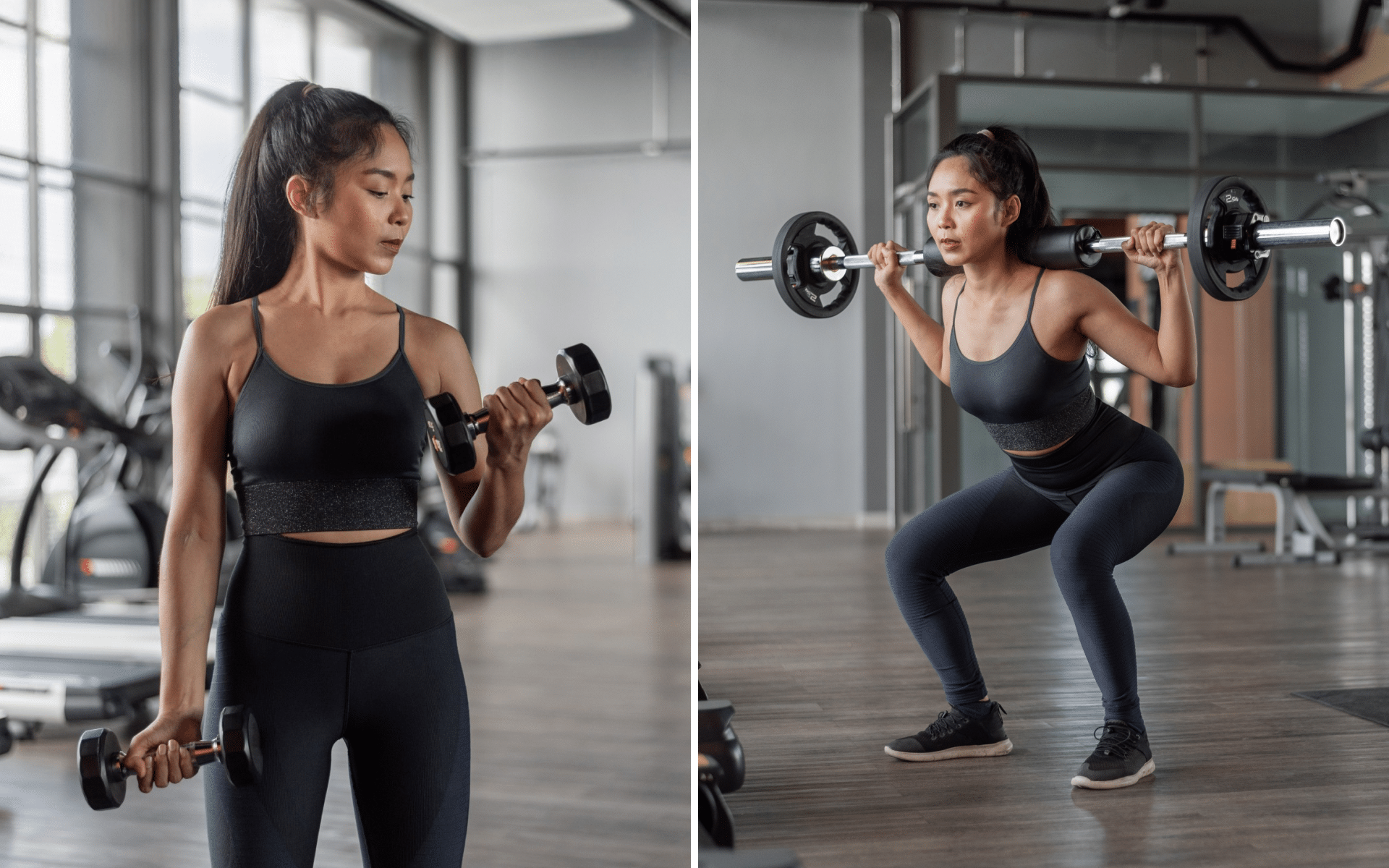When Dr. Izumi Tabata and his research team at the National Institute of Fitness and Sports in Tokyo studied athletes training for the Olympics, they found that short, extremely intense workouts were far more beneficial than longer, less intense ones (6). While most people think that long aerobic workouts are the key to improving cardiovascular fitness, the Tabata protocol has shown to be a much more effective way to increase both aerobic and anaerobic capacity. When you’re new to exercise, the thought of working out for 4 minutes might not seem like a lot. But when those 4 minutes are spent at maximum effort, they can feel like an eternity. Read on to discover the science behind this killer tabata intervals and how you can use it to your advantage.
What Is The Tabata Protocol?
Tabata training is a form of high-intensity interval training (HIIT) that consists of 20 seconds of all-out effort followed by 10 seconds of rest. This cycle is repeated 8 times for a total of 4 minutes.
While it may not seem like much, 4 minutes of Tabata is equivalent to 20 minutes of traditional aerobic training.
Tabata uses both the anaerobic and aerobic systems, which is also the reason why it is effective. The all-out effort bursts train the anaerobic system, while the 10-second rest periods train the aerobic system.
This type of training is incredibly efficient and has been shown to improve both VO2 max (a measure of aerobic fitness) and anaerobic capacity (11).
Is Tabata Better Than HIIT?
While HIIT has become a popular workout method in recent years, the Tabata protocol is unique in its intensity and brevity. Plus, it’s structured, which means you won’t be looking to create your own HIIT workout on the fly.
A typical HIIT workout might last for 30 minutes or more and include several minutes of warm-up and cool-down. You have to choose your own exercises, work at your own pace, and monitor your own heart rate.
Tabata is different in that it’s a short, specific, and intense workout. It’s a structured protocol that’s just four minutes long, with no warm-up or cool-down. This makes it a very time-efficient workout, which is one of the reasons it’s so popular.
The other reason is that it’s an incredibly effective way to improve both aerobic and anaerobic fitness.
Aerobic fitness is the ability of your heart and lungs to deliver oxygen to your muscles during prolonged exercise. Anaerobic fitness, on the other hand, is the ability of your muscles to produce energy without oxygen (1).
Both are important for overall fitness and health, but they’re used in different ways.
Aerobic exercise is typically lower intensity and can be performed for long periods of time. Walking, jogging, and biking are some examples of aerobic exercise.
Anaerobic exercise is higher intensity and can only be performed for short periods of time. Sprinting and lifting weights are some examples of anaerobic exercises.
The Tabata protocol is a great way to improve both aerobic and anaerobic fitness because it alternates between high-intensity intervals and low-intensity periods.
This allows you to work at your maximum effort for short periods of time, followed by active rest where your heart rate and breathing return to normal.
Not only is the Tabata protocol a great workout for improving fitness, but it can also be used as a tool for fat loss (5).
HIIT workouts are known to be more effective than traditional cardio for burning fat. This is because they help you burn more calories both during and after the workout (7). The Tabata protocol is an especially effective form of HIIT because of its intensity. Research has shown that HIIT results in greater training compared to moderate-intensity continuous training (10).
Read More: 7-Minute Fat Burning Tabata Workout
What Is The Formula For A Tabata Workout?
Taking advantage of the structured nature of the Tabata protocol is key to getting the most out of your workout.
While you can certainly create your own Tabata workouts, there’s a specific formula you can follow to make sure you’re getting the most out of your 4 minutes.
The formula is simple: 20 seconds of all-out effort followed by 10 seconds of rest. This cycle is repeated 8 times for a total of 4 minutes.
You can use any type of exercise you want, but it’s important to choose something that you can do at maximum effort for 20 seconds.
Some examples of exercises you can use for a Tabata workout include:
Burpees
Burpees are a full-body exercise that is great for Tabata because they can be done at a high intensity.
To do Burpees:
- Stand with your feet shoulder-width apart.
- Bend down and place your hands on the ground in front of you.
- Kick your feet back so you’re in a push-up position.
- Do one push-up.
- Jump your feet back to the starting position.
- Stand up and jump in the air, reaching your hands overhead.
Mountain Climbers
Mountain climbers are another full-body exercise that is perfect for Tabata.
To do Mountain Climbers:
- Start in a push-up position with your hands shoulder-width apart.
- Keeping your core engaged, bring your right knee to your chest.
- Jump and switch legs, bringing your left knee to your chest.
- Continue alternating legs as quickly as you can.
Squats
Squats are a great exercise for Tabata because they work your entire lower body.
To do Squats:
- Stand with your feet shoulder-width apart.
- Bend your knees and lower your hips until your thighs are parallel to the ground.
- Make sure your knees don’t extend past your toes.
- Stand back up and repeat.
Jump Rope
Jumping rope is a great cardio exercise to use for Tabata because it’s easy to do at a high intensity.
To do Jump Rope:
- Start with your feet together and the rope behind you.
- Swing the rope over your head and jump when it reaches your feet.
- Land lightly on your toes and immediately jump again.
- Continue jumping for the entire 20 seconds.
Whether you’re looking to simply pep up your fitness routine, jazz up your diet with mouth-watering low-calorie recipes or want to get your act together and significantly drop that number on your scale – BetterMe app has got you covered! Improve your body and revamp your life with us!
Push-Ups
Push-ups are a great exercise to use for Tabata because they work your entire upper body.
To do Push-Ups:
- Start in a plank position with your hands shoulder-width apart.
- While keeping your core engaged, bend your elbows and lower your chest to the ground.
- Push back up to the starting position and repeat.
Crunches
Crunches are a great exercise to use for Tabata because they work your entire core.
To do Crunches:
- Lie on your back with your knees bent and your feet flat on the ground.
- Place your hands behind your head.
- Keeping your lower back pressed to the ground, lift your shoulders off the ground and towards your knees.
- Lower back down and repeat.
Reverse Lunges
Reverse lunges are a great exercise to use for Tabata because they engage your entire lower body.
To do Reverse Lunges:
- Stand with your feet shoulder-width apart and your hands on your hips.
- Step backward with your right leg and lunge until your left thigh is parallel to the ground.
- Make sure your right knee doesn’t extend past your toes.
- Push off your right leg and return to the starting position.
- Repeat with your left leg.
High Knees
High knees are a great cardio exercise to use for Tabata because they get your heart rate up.
To do High Knees:
- Stand with your feet shoulder-width apart.
- Keeping your core engaged, bring your right knee to your chest.
- Jump and switch legs, bringing your left knee to your chest.
- Continue alternating legs as quickly as you can.
As you can see, there are many different exercises you can use for a Tabata workout. The important thing is to choose an exercise that you can do at a high intensity for the 20-second intervals.
Read More: Tabata Yoga: This Hardcore Workout Will Have You Sweating Up A Storm Within Minutes
How Many Tabata Intervals Should I Do?
In the study mentioned above, the participants did 8 rounds of 20 seconds of intense exercise followed by 10 seconds of rest. So, Dr. Tabata’s protocol calls for a total of 8 Tabata intervals. This was repeated 5 times a week for a total of 4 weeks (6).
This schedule might not work for you for a number of reasons, such as:
- As a beginner, doing 8 rounds of 20 seconds of intense exercise might be a bit too difficult to achieve.
- You might not have time for a 5-day-a-week workout.
- Maintaining the intensity for 8 rounds might be impossible for you.
So, how many Tabata intervals should you do? Think of 8 rounds as the minimum. If you can do more, go for it. You can modify the protocol to fit your fitness level and schedule.
For example, if you’re a beginner, set a target of 8 rounds but be flexible on how long each interval is. 20 seconds might be too long, so start with 10 seconds and work your way up.
If you don’t have time for a 5-day-a-week workout, try 3 days a week instead. Or, if you’re short on time, break up the 8 rounds into 2 or 3 sets. For example, do 4 rounds in the morning and 4 rounds in the evening.
The important thing is to find a schedule that you can stick with. Remember, consistency is key when it comes to workout routines.
Science-Backed Benefits Of Tabata Protocol
So, what are the benefits of following the Tabata protocol? Let’s take a look at the science.
1. Boosts Metabolism
Your metabolism is the process your body uses to convert the food you eat into energy. A higher metabolism means you burn more calories, even at rest (3).
Here’s how Tabata can help:
When you do a Tabata workout, your body has to work harder to repair the muscles you’ve just worked. This process, called excess post-exercise oxygen consumption (EPOC), can last up to 48 hours (4).
In other words, your body continues to burn calories long after you’ve finished your workout.
2. Increases Anaerobic And Aerobic Capacity
Anaerobic capacity is the amount of work you can do in a short burst of intense activity. For example, sprinting up a hill.
Aerobic capacity is the amount of work you can do in a sustained period of moderate activity. For example, running at a steady pace.
Tabata interval training has been shown to increase both anaerobic and aerobic capacity by up to 28% (6).
If you struggle to even flirt with the idea of giving up your favorite foods or working out till your legs give way – BetterMe app is here to breathe a fresh perspective into the way you view the weight loss process! Check out the app and experience the fun side of fitness and dieting with BetterMe!
3. Increases Lean Muscle Mass
Lean muscle mass is the amount of muscle in your body without fat.
Increasing lean muscle mass has a number of benefits (9), including helping you:
- Burn more calories at rest
- Improve insulin sensitivity
- Reduce the risk of injuries
Since Tabata interval training is a form of high-intensity interval training (HIIT), it’s an effective way to build lean muscle mass (2).
4. Increases Cardiovascular Health
Tabata interval training has been shown to improve cardiovascular health (8). By improving your cardiovascular health, you reduce your risk of heart disease and stroke.
Tabata Intervals: The Bottom Line
If you’re looking for a workout that is short and sweet, Tabata intervals might be for you. This type of workout is a great way to get your heart rate up and burn some serious calories. Moreover, it is time efficient and effective, which makes it a perfect workout for those who are busy with work and such.
While Tabata intervals are set up as a 4-week program, you can modify the protocol to fit your fitness level and schedule.
Get your personalized
meal plan!
DISCLAIMER:
This article is intended for general informational purposes only and does not serve to address individual circumstances. It is not a substitute for professional advice or help and should not be relied on for making any kind of decision-making. Any action taken as a direct or indirect result of the information in this article is entirely at your own risk and is your sole responsibility.
BetterMe, its content staff, and its medical advisors accept no responsibility for inaccuracies, errors, misstatements, inconsistencies, or omissions and specifically disclaim any liability, loss or risk, personal, professional or otherwise, which may be incurred as a consequence, directly or indirectly, of the use and/or application of any content.
You should always seek the advice of your physician or other qualified health provider with any questions you may have regarding a medical condition or your specific situation. Never disregard professional medical advice or delay seeking it because of BetterMe content. If you suspect or think you may have a medical emergency, call your doctor.
SOURCES:
- Aerobic vs anaerobic exercise training effects on the cardiovascular system (2017, ncbi.nlm.nih.gov)
- Can High-Intensity Interval Training Promote Skeletal Muscle Anabolism? (2021, link.springer.com)
- Control of energy expenditure in humans (2016, nature.com)
- Effect of exercise intensity, duration and mode on post-exercise oxygen consumption (2003, pubmed.ncbi.nlm.nih.gov)
- Effect of HIIT with Tabata Protocol on Serum Irisin, Physical Performance, and Body Composition in Men (2020, mdpi.com)
- Effects of moderate-intensity endurance and high-intensity intermittent training on anaerobic capacity and ˙VO2max (1996, journals.lww.com)
- High-Intensity Intermittent Exercise and Fat Loss (2011, hindawi.com)
- High-intensity interval training for health benefits and care of cardiac diseases – The key to an efficient exercise protocol (2019, ncbi.nlm.nih.gov)
- Increasing muscle mass to improve metabolism (2013, ncbi.nlm.nih.gov)
- Is interval training the magic bullet for fat loss? A systematic review and meta-analysis comparing moderate-intensity continuous training with high-intensity interval training (HIIT) (2019, pubmed.ncbi.nlm.nih.gov)
- Tabata training: one of the most energetically effective high-intensity intermittent training methods (2019, jps.biomedcentral.com)













